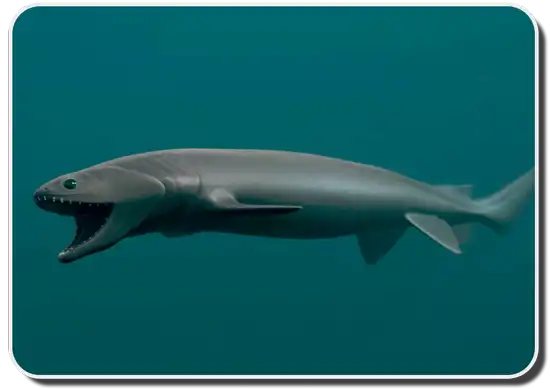The Frilled Shark, aka frill shark or living fossil, is one of the least seen amongst sharks because of the depths in which it lives. With 25 rows that maintain 300 triangular shaped needle sharp teeth, there is no need for humans to fear them; those seemingly formidable grinders were created to consume other sea animals that reside in depths similar to the Frilled Shark itself. One that was recently dissected revealed a diet of squid, cuttlefish, octopus and other sharks. It is believed that their diet is more than 60% cephalopods (marine mollusks). The creatures found within the Frilled Shark’s stomach were slippery and its teeth were perfect for devouring their flesh.

What A Big Mouth!
Although the mouth of a Frilled Shark gives an appearance of being grander in size than other sharks, it is merely due to the fact that its mouth continues to the rear of its head, as opposed to ending beneath the skull. Its head initially gives one the impression that it is one huge mouth filled with teeth. At the end, which is the throat, there is an area of six frilled gills with the initial gill slit placed across the throat as if it were cut with a blade. This entire area gives them their name, although they officially go by Chlamydoselachus Anguineus.

The Shark That Looks Like An Eel
If you’re an admirer of eels and have yet to discover this shark, their bodies are nearly indistinguishable to the eel with the exception of the fins. These fins include a dorsal, pectoral, anal and prolonged caudal fin. Although their bodies are similar to eels’ scientists say a Frilled Shark most likely attacks its prey in a manner resembling that of a snake. To date, we have no actual footage or witness of one hunting or eating, but scientists have established the likelihood of them using crevices as well as caves that are located throughout the continental slopes to feed. This conclusion provides a realistic rationale for their slender bodies.
Mating And Offspring
It is also construed that they have the capability of gestating up to 78 months (three and a half years), which would make them record holders on the length of a gestation period. Their litters have an average of six pups, but many of them do not live long enough to become adults. So while it is conceived that they might have the lengthiest duration of gestation, their inability for all of their pups to live full life spans affects the quantity of of their existence.
Living In The Deep
Living in such deep waters has its drawbacks because temperatures are freezing; therefore, the metabolic cycle of this shark is somewhat lethargic. Those who fish for a living could rarely obtain their prey at the depths in which they reside, so they were able to continue to thrive when other sea creatures where directly affected by modern capabilities and supposed advances. This factor makes them prehistoric, hence the nickname living fossil. However, now that equipment can go more than 4,000 feet (1,220 m) below the water’s surface, they are being apprehended frequently.
Human Impact
Scientists have also devised that these sharks are being affected by pollutions making them susceptible to illness, in addition to changes in climates that have affected the waters temperatures and numerous other current day issues. Frilled Sharks have hydrocarbon and oil filled livers that are responsible for their ability to float or hover in waters of 160-660 feet (48-201 m), but while we’re excited to learn of them first hand, we are disappointed to see them being removed from the waters in which they’ve lived for more years than humans have, by those who are curious, fishermen and overall unnecessary capture. They are misfortunately killed in the nets of trawlers in Japan, and have been found in fertilizers, animal food, and even our food. They are listed by the World Conservation Union as being a species near threatened.
Habitat
Map Of The Frilled Shark’s Habitat

You already know how excited we are on this site about sharks, and the Frilled Shark is just another magnificent shark we are fortunate enough to share with you. In order to see one in the wild, you’ll most likely have to reside in or be visiting Australia, New Zealand, Southeast Asia, West Africa, Chile or the Caribbean. The map below shows some of the areas the Frilled Shark has been spotted. It is not a given that you will spot any, but if so, please don’t remove them from the waters and fear not, there aren’t the Loch Ness Monsters as previously accused of being, nor are they sea serpents or devil like eels. Frilled Sharks are indeed one of Earth’s oldest beings, and on our list of most interesting creations.
